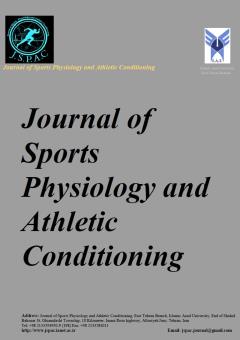The role of exercise genomics in preventive medicine
Subject Areas : Sport PhysiologyMirzahossein Norouzi Kamareh 1 , Fatemeh Rostamkhani 2
1 - Exercise Physiology Research Center, Life Style Institute, Baqiyatallah University of Medical Sciences, Tehran, Iran
2 - Department of Biology, Yadegar-e-Imam Khomeini (RAH) Shahre Rey Branch, Islamic Azad University, Tehran, Iran
Keywords: Exercise, Genomics, Preventive medicine,
Abstract :
Dear Editor Regular exercise and physical activity are effective preventative measures for over 25 chronic medical conditions, including cardiovascular disease and premature death. According to the World Health Organization, physical inactivity is the fourth leading risk factor for death, killing about 3.2 million people annually (1). It is accepted that an individual's behavior is due to three factors: biological/genetic influences, environmental influences, and/or the interaction between biological and environmental factors. There are biological/genetic differences in sexual activity that are distinct from environmental influences on activity (2). Today, the development of genetic evaluation methods throughout the human genome has made it possible for sports scientists and physicians to study genetic factors that play a role in regular physical activity and exercise in preventing chronic diseases. Studies have shown that there is an interaction of the gene × physical activity in reducing the risk factors for type 2 diabetes, obesity, and cardiovascular disease. In the following, we will review several studies in this regard.
1. Warburton DE, Bredin SS. Reflections on Physical Activity and Health: What Should We Recommend? Can J Cardiol. 2016 Apr;32(4):495-504. doi: 10.1016/j.cjca.2016.01.024. Epub 2016 Mar 17. PMID: 26995692.
2. Charney E. Genes, behavior, and behavior genetics. Wiley Interdiscip Rev Cogn Sci. 2017 Jan;8(1-2). doi: 10.1002/wcs.1405. Epub 2016 Dec 1. PMID: 27906529.
3. Seaquist ER, Anderson J, Childs B, Cryer P, Dagogo-Jack S, Fish L, Heller SR, Rodriguez H, Rosenzweig J, Vigersky R; American Diabetes Association; Endocrine Society. Hypoglycemia and diabetes: a report of a workgroup of the American Diabetes Association and the Endocrine Society. J Clin Endocrinol Metab. 2013 May;98(5):1845-59. doi: 10.1210/jc.2012-4127. Epub 2013 Apr 15. PMID: 23589524.
4. Stanford KI, Goodyear LJ. Exercise and type 2 diabetes: molecular mechanisms regulating glucose uptake in skeletal muscle. Adv Physiol Educ. 2014 Dec;38(4):308-14. doi: 10.1152/advan.00080.2014. PMID: 25434013; PMCID: PMC4315445.
5. Meirhaeghe A, Helbecque N, Cottel D, Amouyel P. Beta2-adrenoceptor gene polymorphism, body weight, and physical activity. Lancet. 1999 Mar 13;353(9156):896. doi: 10.1016/S0140-6736(99)00251-2. PMID: 10093985.
6. Corbalán MS, Marti A, Forga L, Martínez-González MA, Martínez JA. The 27Glu polymorphism of the beta2-adrenergic receptor gene interacts with physical activity influencing obesity risk among female subjects. Clin Genet. 2002 Apr;61(4):305-7. doi: 10.1034/j.1399-0004.2002.610411.x. PMID: 12030897.
7. Franks P, Luan J, Browne P, Harding A-H, O’Rahilly S, Chatterjee V, et al. Does peroxisome proliferator-activated receptor γ genotype (Pro12ala) modify the association of physical activity and dietary fat with fasting insulin level? Metabolism. 2004;53(1):11-6.
8. Elagizi A, Kachur S, Carbone S, Lavie CJ, Blair SN. A Review of Obesity, Physical Activity, and Cardiovascular Disease. Curr Obes Rep. 2020 Dec;9(4):571-581. doi: 10.1007/s13679-020-00403-z. PMID: 32870465.
9. Albuquerque D, Nóbrega C, Manco L, Padez C. The contribution of genetics and environment to obesity. Br Med Bull. 2017 Sep 1;123(1):159-173. doi: 10.1093/bmb/ldx022. PMID: 28910990.
10. Rankinen T, Pérusse L, Rauramaa R, Rivera MA, Wolfarth B, Bouchard C. The human gene map for performance and health-related fitness phenotypes. Med Sci Sports Exerc. 2001 Jun;33(6):855-67. doi: 10.1097/00005768-200106000-00001. PMID: 11404647.
11. Bray MS. Implications of gene-behavior interactions: prevention and intervention for obesity. Obesity (Silver Spring). 2008 Dec;16 Suppl 3(Suppl 3):S72-8. doi: 10.1038/oby.2008.522. PMID: 19037218; PMCID: PMC2703301.


